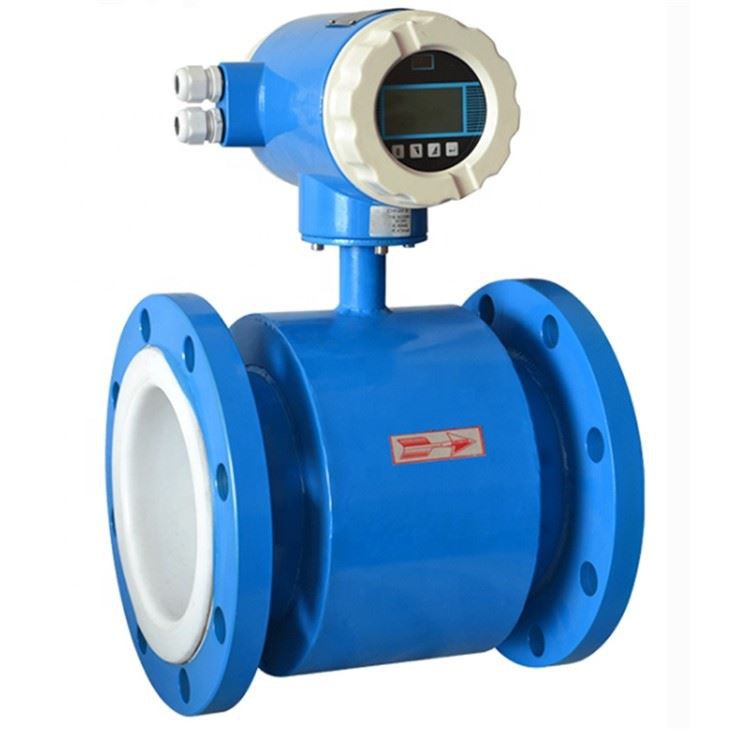Pulp Flow Meter

Pulp Flow Meter
2. Type: remote type, integrated type, plug-in type
3. Lining material: neoprene, PTFE, PFA, FEP, F46
4. Electrode material: SS316L, HC, HB, Ti, Tan, Pt
Introduce:
Pulp flow meter is suitable for all conductivity greater than 5μs/cm (μS/cm is micro Siemens per centimeter, which is equivalent to 0.1mS/m millisiemens per meter. It is inversely proportional to resistance MΩ cm (mega ohm). That is: 0.1μS /cm=10MΩ·cm Conductive liquid flow measurement). There are no moving and clogging parts in the measuring tube, minimal loss, no clogging, and easy maintenance. The performance of the electromagnetic flowmeter is not affected by the pressure, temperature and density changes of the measured liquid. The electromagnetic flowmeter sensor adopts low-frequency multi-state excitation, which is not affected by artificial frequency and various disturbances on site. It has the characteristics of strong adaptability, good stability and low installation requirements.
Product Image:
 |  |
Introduction to the protection level of Pulp flow meter:
*IP65, IP67, IP68:
*IP65: Dust-tight, water-proof.
*IP67: Dust tight, can be immersed in water for a short time
*IP68: Dust tight, can be continuously immersed in water
*Explosion-proof type: It means that if there is a flammable and explosive medium in the air, such as a gas station, it is required to
Lining introduction:
1.Neoprene Lining:
* Oil resistance, solvent resistance, oxidation resistance, general acid and alkali, salt and other medium corrosion resistance, not resistant to oxidative medium corrosion.
* Has excellent elasticity and wear resistance. But the cold resistance is poor.
*Applicable range: 1.0℃-80℃ non-strong acid, strong alkali, strong oxidizing medium. It can measure abrasive weak sewage, mud and ore pulp.
2.Polytetrafluoroethylene (PTFE)
*PTFE is a material with the most stable chemical properties in plastics; it is resistant to boiling hydrochloric acid, sulfuric acid, nitric acid and aqua regia, concentrated alkali and various organic solvents, but not resistant to chlorine trifluoride, high temperature oxygen fluoride, high flow rate Corrosion of liquid fluorine, liquid oxygen and ozone.
B. Poor wear resistance and negative pressure resistance.
C. Scope of application: -25 degrees -140 degrees, strong corrosive substances such as concentrated acid and alkali, and sanitary media such as drinking water, milk, beer, beverages, etc.
3.Teflon (PFA)
*Good hydrophobicity and non-stickiness, strong high temperature resistance.
*Excellent corrosion resistance, strong acid, alkali, organic solvent and various salt solutions.
* The ability to resist negative pressure is good. When the anti-negative pressure requirement is high, a metal mesh can be added to improve the negative pressure resistance.
*Poor wear resistance.
*Applicable range: -25 degrees -140 degrees of non-strong wear media, sanitary media.
Electrode introduction:
1. Molybdenum-containing stainless steel (316L)
It is used in industrial water, sewage, inorganic acid, weak corrosive medium, and can be widely used in petroleum, chemical, urea, vinylon and other industries.
2. Hastelloy B (HB)
It has good corrosion resistance to all concentrations of hydrochloric acid below the boiling point, and is also resistant to corrosion by non-oxidizing acids, alkalis, and non-oxidizing salt solutions such as sulfuric acid, phosphoric acid, hydrofluoric acid, and organic acids.
3. Hastelloy B(HC)
Resistance to oxidizing acid corrosion, such as nitric acid, mixed acid or mixed medium corrosion of chromic acid and sulfuric acid, and corrosion resistance to oxidizing salts such as FE+++, CU++ or other oxidizing agents. Such as the corrosion of hypochlorite solution and seawater above normal temperature.
4. Titanium (Ti)
Corrosion resistance to seawater, various chlorides and hypochlorites, oxidizing acids (including fuming nitric acid), organic acids, alkalis, etc., but not to pure reducing acids (such as sulfuric acid, hydrochloric acid). .However, if the acid contains an oxidizing agent (such as nitric acid, FE+++, CU++), corrosion will be reduced.
5. Tantalum (Ta)
Has excellent corrosion resistance, very similar to glass. Except for hydrofluoric acid, oleum and alkali, it is resistant to corrosion by almost all chemical media (including boiling point hydrochloric acid, nitric acid, aqua regia and sulfuric acid below 175 degrees), and it is not corrosion-resistant in alkali.
6. Platinum iridium alloy
For all chemicals, resistant to corrosion (e.g. acids, alkalis, various salts), but not to aqua regia.
FAQ:
1. Question: How about the accuracy of the Pulp flow meter?
A: The accuracy can reach 0.5%, and the highest can reach 0.2%.
2. Question: Can it measure the mixture containing particles in the liquid?
A: Yes. The liquid contains particles, if the particle diameter is small, the measurement is completely possible.
3. Q: What is the MOQ?
A: MOQ 1PCS.
4. Q: Can I visit your factory?
A: Sure, we welcome you to visit our factory if you need.
5.Q: What is the payment method?
A: TT payment, credit card online payment, RMB payment, Western Union payment, LC payment
Application flow meter calibration device:
Our factory has professional calibration equipment and professional calibration engineers. When the flowmeter for mud application leaves the factory, professional calibration engineers use the 5-point calibration method to calibrate the flowmeter one-to-one to ensure that the accuracy of the flowmeter can reach 0.5%, and the highest can reach 0.5%. up to 0.2%.